“Portrait of a Lady” has been added to your cart.
View cart
-
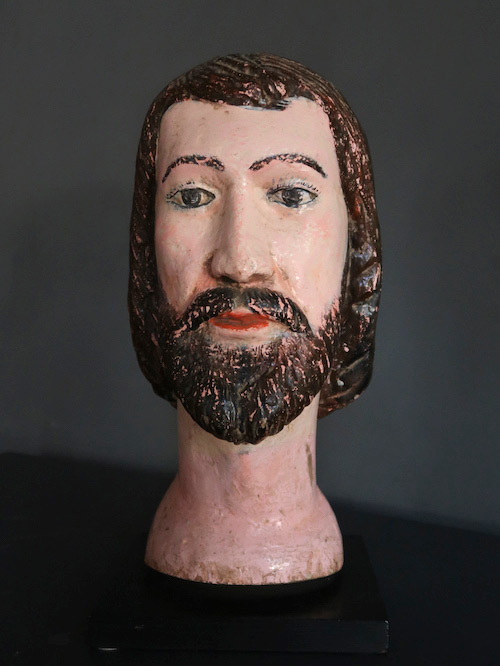
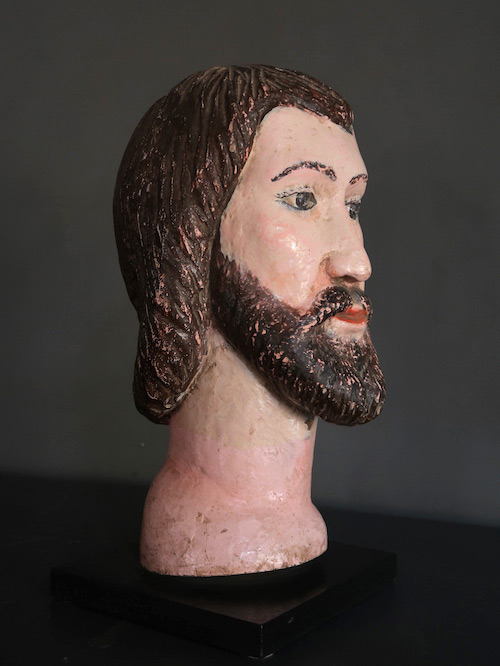
Indo-Portuguese, probably Goa
Polychromed wood
Saints figures normally used in processions, were called ‘Cribb’ (skeletal) figures, and were common in the East as well as in Portugal, Spain and Italy. In these figures most of the artistic effort went into rendering the head. The body comprised a simple wood structure which would be dressed, thus avoiding the need to sculpt the entire figure. To this were attached the head, hands and feet.
Size(cms): 44 (H) x 19 (W) x 19 (D)
Size(inches): 17 (H) x 7.5 (W) x 7.5 (D)
-
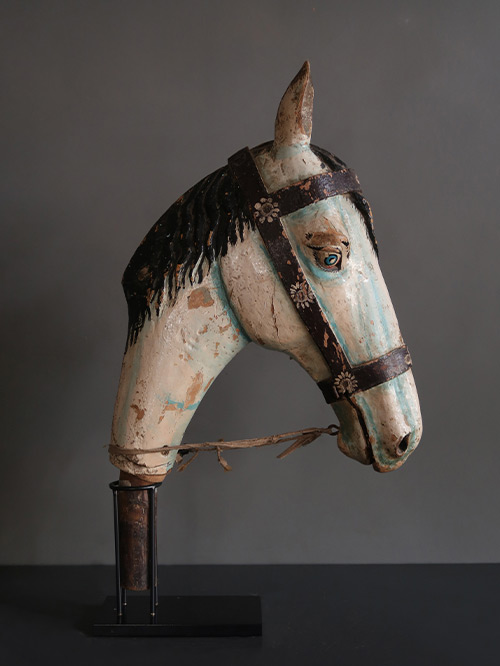
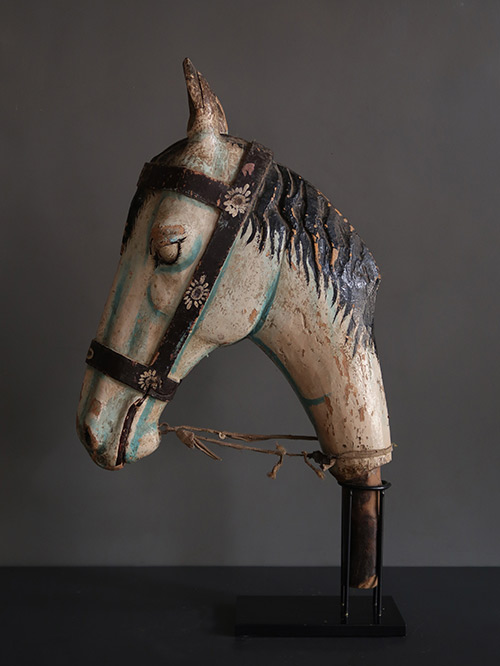
Konkan Region (Western India)
wood, polychromed
A painted wooden horse dancing mask with an articulated jaw. The head is worn through use but still shows its typical trappings.
This is a tribal dancing masks from the Konkan region used in the Perni Zagor, a folk play danced by Christian Gaud tribals. Perni Zagor is an indigenous dance-drama form of the Perni community of Goa. This is an ancient art form and is believed to have evolved on the banks of the Zuari river. It has its origins in fertility rites related to Neolithic shamanism. The dancers don wooden masks while performing the musical drama. The masks represent deities, animals, birds and demons. The characters are derived from various episodes in Hindu mythology. Perni Zagor is currently performed by only a few families in the community and is almost on the verge of extinction.
Size (cms): 77(H) x 44(W) x 17(D)
Size (inches): 30.5(H) x 17.5(W) x 6.5(D)
-

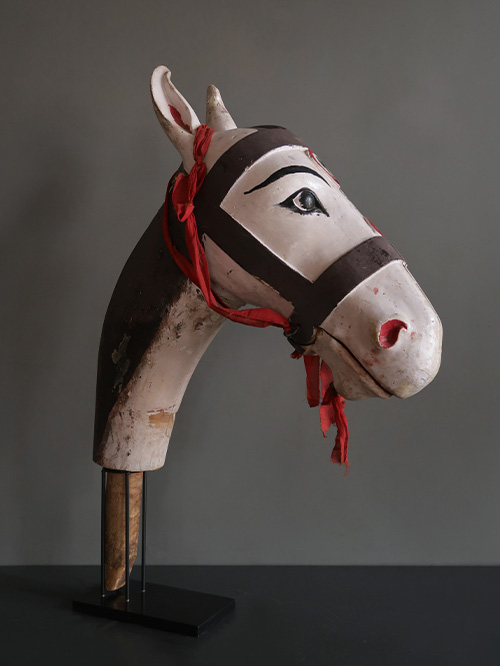
Konkan Region (Western India)
wood, polychromed
A painted wooden horse dancing mask with an articulated jaw. The head is worn through use but still shows its typical trappings.
This is a tribal dancing masks from the Konkan region used in the Perni Zagor, a folk play danced by Christian Gaud tribals. Perni Zagor is an indigenous dance-drama form of the Perni community of Goa. This is an ancient art form and is believed to have evolved on the banks of the Zuari river. It has its origins in fertility rites related to Neolithic shamanism. The dancers don wooden masks while performing the musical drama. The masks represent deities, animals, birds and demons. The characters are derived from various episodes in Hindu mythology. Perni Zagor is currently performed by only a few families in the community and is almost on the verge of extinction.
Size (cms): 86.5(H) x 57(W) x 17(D)
Size (inches): 34(H) x 22.5(W) x 6.5(D)
-

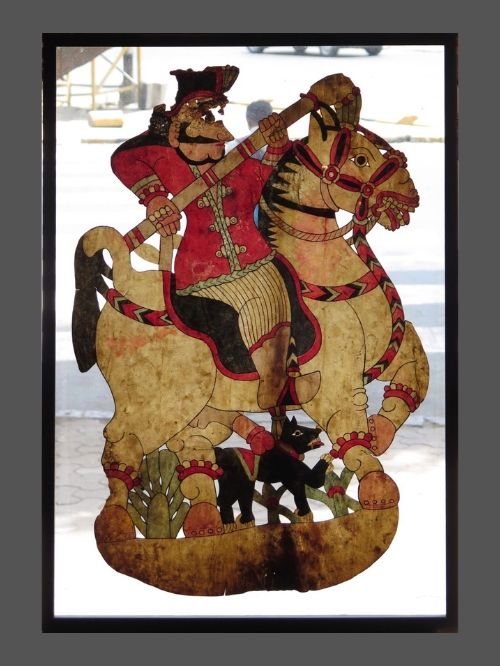
Karnataka (South India)
Framed Leather Shadow Puppet
The art of puppetry, called Togalugombayeta in Karnataka, involves acting out well known epic episodes using puppets made of flat leather pieces operated by a stick. The perforated leather is illuminated from behind, making this a form of shadow theatre. It is thought that the puppets were invented to avoid having gods and goddesses – who feature prominently in Indian epics like the Ramayana and Mahabharata – depicted by humans.
Size(cms): 91 (H) x 62 (L)
Size(inches): 35.8 (H) x 13.4 (L)
-
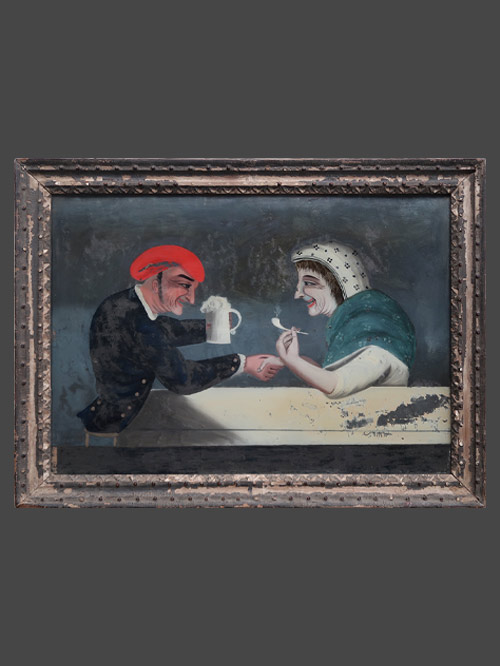
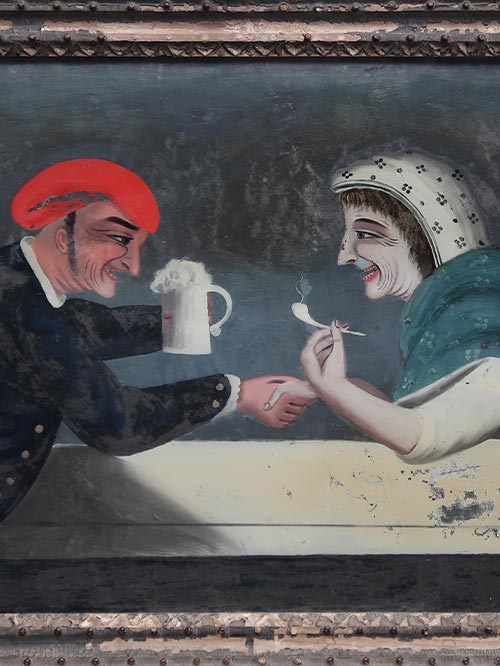
Western India
reverse painting on glass by a Chinese Artist
The love for the exotic is amply demonstrated by this copy of a Dutch genre painting or engraving. An aged couple sit at the table; their curved shoulders and wrinkled faces unmercifully rendered. The man, in a red cap and dark jacket with metal buttons, carries in one hand a tankard filled with beer whose head is almost running over its rim. He warmly shakes the hand of the woman, who holds a pipe in her left hand. Her head is covered by a light coloured cloth and her shoulders are swathed in an indigo shawl, both executed in tie and dye technique. These items, imported from India, were extremely fashionable in eighteenth and nineteenth century Europe. A shaft of light falls on the table and on the couple, setting off the man’s cap and the woman’s head cloth and shawl on an otherwise grey background.
Reverse glass paintings were introduced into India the late 18th century from China by way of the China Trade. Indian artists adopted the technique of reverse glass painting partly on account of its novelty and also because it was a relatively inexpensive medium which could produce rich effects. The technique proved extremely popular and soon spread through western and southern India and even to former provincial Mughal capitals of Oudh, Murshidabad.
What is also significant is that there were some Chinese painters at work in India as well. One is known to have been at the court of Tipu Sultan and a large number of his paintings are in the collection of the Jagmohan Palace Art Gallery at Mysore. A lively market for reverse glass paintings, mainly depicting Hindu deities and portraiture by Chinese artists likely flourished, particularly on the west coast in places like Surat and Cambay.
Size Framed (cms): 42 (H) x 57 (L)
Size Framed (inch): 16.5 (H) x 22.4 (L)
Size Painting (cms): 34 (H) x 49 (L)
Size Painting (inch): 13.4 (H) x 19.3 (L)
-

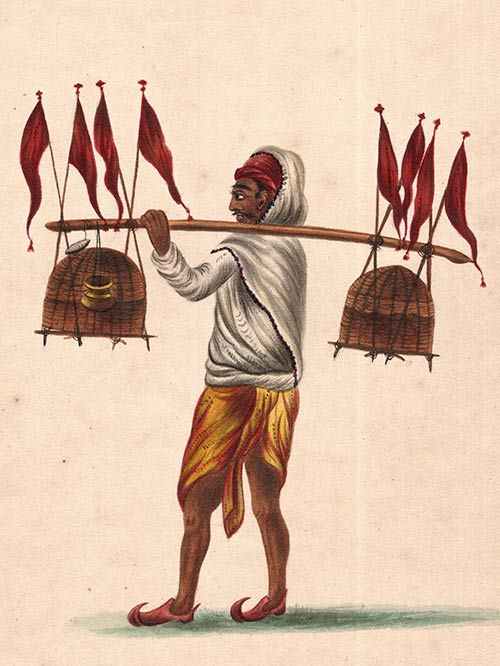
Patna (Eastern India)
Opaque watercolour on European paper
This captivating Company Painting depicts a man carrying two baskets suspended on a pole, with red flags attached at either end. A brass lota peeks out from one of the baskets. The water carrier is on his way back from Benares carrying the holy water from the sacred river
Under the Mughals Patna had never been a great artistic centre and although its Muhammadan governors had employed Mughal artists, there is no evidence that any strongly marked local style had developed. Yet Patna, like Murshidabad, was undergoing a social revolution and various circumstances in the later eighteenth century were to make it a centre of Indian-British painting. As a result of its increasing prosperity, a number of artists of the Kayasth caste were attracted to Patna from Murshidabad. One of these was a certain Sewak Ram, who had migrated there by I790. He began to produce sets of occupations as well as large paintings of ceremonies and festivals. One such set, now in the India Office Library, was purchased by Lord Minto, while a painting from a similar set in the Indian Department of the Victoria and Albert Museum was acquired by Lord Amherst when he was Governor-General (August 1823 to March 1828). British taste in the early nineteenth century shows itself in both subjects and colour range – sepia wash enlivened with touches of brighter colour – adopted by the Patna artists.
Painting Size (cms): 23(H) x 18.5(W)
Painting Size (inches): 9(H) x 7.5(W)
-
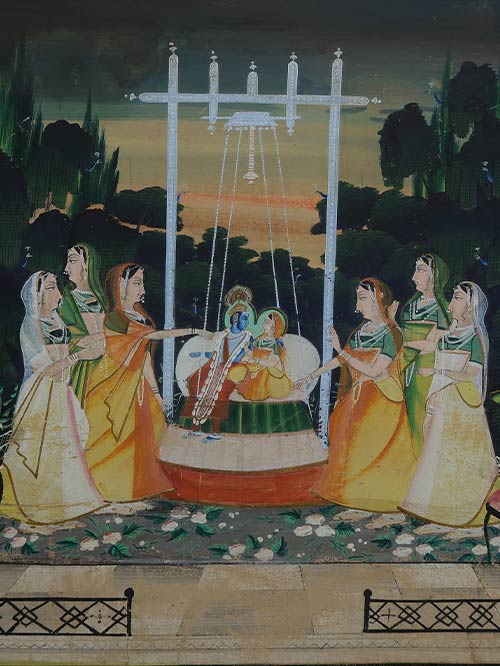
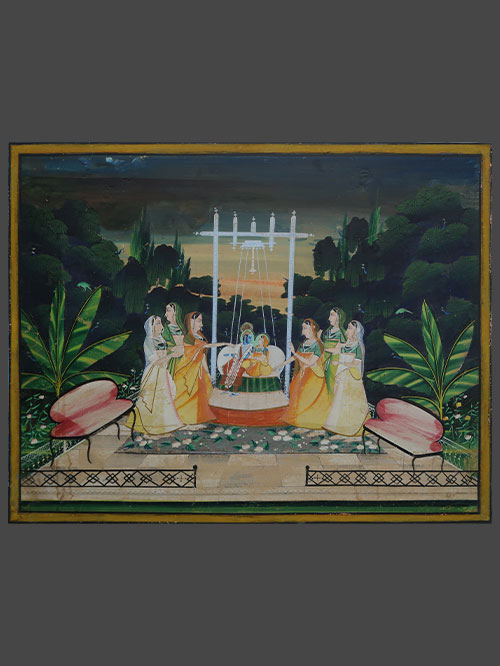
Nathdwara (Rajasthan)
opaque watercolour and gold on paper
Krishna and Radha sit resting against a large white bolster on an ornate silver swing. Underfoot is a floral decorated carpet on a chequered marble floor with iron balustrades. Six female attendants flank the nimbate couple whose gazes are firmly fixed on each other. In the foreground are a pair of European style pink settees while in the distance an orange hued sky indicates the setting sun. Dense clusters of trees and foliage sprinkled with parrots and peacocks envelope the central scene.
Such large and dramatic scenes were painted by Nathdwara artists who produced these images for devotees who visited the great Krishna temple at Nathdwara in Rajasthan. Founded in the 17th century, this temple has attracted an enormous following even to this day, in turn ensuring a continuing tradition of devotional images. The extravagant size and conception of these paintings remind one of the constant importance of religious images in India, not only as ritual objects but also items for pilgrims to acquire and bring home from the great Hindu shrines.
Towards the end of the nineteenth century and early twentieth century Nathdwara artists were exposed for the first time to European art prints whose influence can be seen in the paintings of this period.
Size Painting (cms): 44.5 (H) x 57 (W)
Size Painting (inch): 17.5 (H) x 22.4 (L)
-
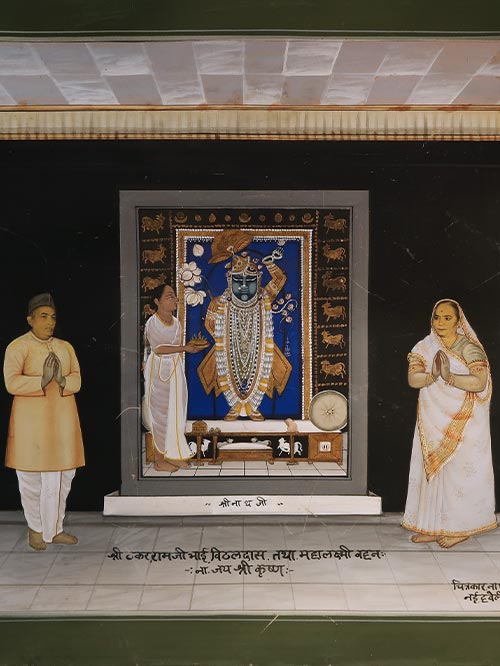
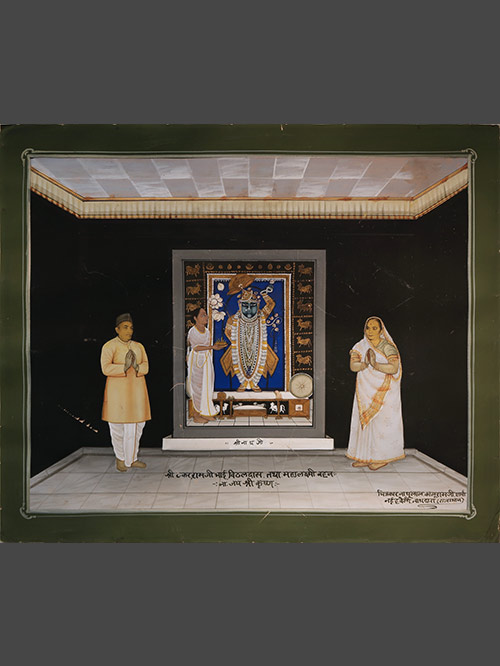
Nathdwara (Rajasthan)
Opaque watercolour, gold and gelatin silver print on paper
Inscribed on recto ‘Nathulal Kaluramji Sharma, Nathdwara’
In Pushti Marga terminology, to perform a manoratha is to offer a seva ( ritualistic service) to the deity in fulfilment of a long cherished inner yearning to serve him in a special way on a particular day. Only a few select Goswamis, direct descendants of Vallbhacharya, are given this privilege and every Goswami longs to perform a manoratha at least once in a lifetime. A wealthy devotee can also perform a manoratha on an important day of his life or in the fulfilment of a vow. This is done by contributing towards the expenses of a particular darshana ( formal viewing of a deity) or by paying for the seva of an entire day. To commemorate this event, devotees usually commission a painting showing them on both sides of Srinathji outside the threshed of the sanctum. In the present painting actual photographs of the donors faces are incorporated into the painting. This served as a visual record of their worship before the famed icon.
Sri-Nathji ( The Lord of Shri, Goddess of Wealth) enshrined at Nathdwara is the most important svarupa (own form) in the Pushti Marga, and represents Krishna at the age of seven. Sri-Nathji is Krishna incarnate, the tutelary deity of the Vallabhacharya whose swarupa or image is enshrined at Nathdwara.
Painting Size (cms): 50.5 (H) x 60.5 (L)
Painting Size (inch): 19.9 (H) x 23.8 (L)
-
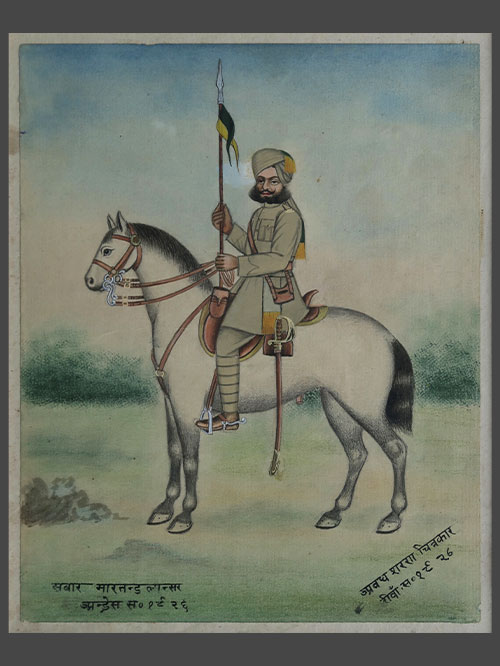
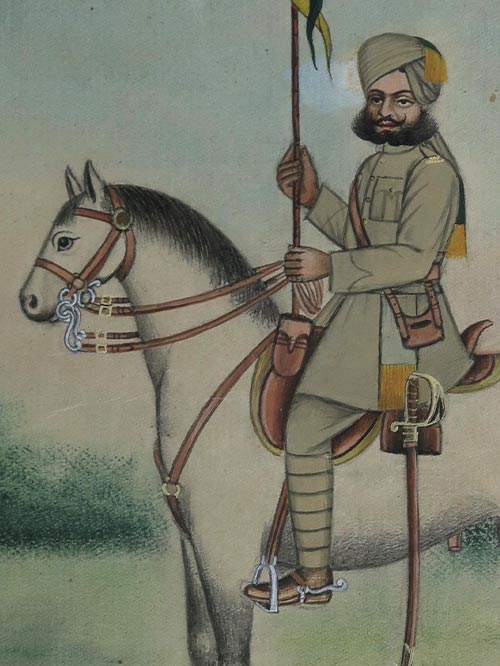
Rewa (Central India)
pigments on paper
Company Painting, Signed by the artist Avadh Sharan
A charming Company painting of a lancer captioned, “Rider Maartand Lancer.” Originally bound in an album. Lancers were a type of cavalryman who fought with lances, a pole weapon similar to a spike or spear. The first armoured troops in India were formed in 1914. In 1921, the Indian Army cavalry regiments were reorganised, and consolidated into twenty-one regiments. During this period, the Indian army was a separate organisation to the British Army. The main task of the Indian Army was to police the Indian Empire. During the first and second world wars, Indian troops served with distinction in France in 1940, Egypt, Libya, the Sudan, Abyssinia, Syria, Persia, Iraq, Malaya and Burma.
‘Company’ is a designation given to works by Indian artists painted in a mixed Indo-European style for the various East India companies. The foundation of this Indo-European style can be traced to the establishment of the first Portuguese trading posts. The British only counted as patrons in the 1760s following Clive’s victory at Plassey in 1757 . Patronage by the British in effect followed the flag. Princely states never directly under British control produced little company art and important centres like Delhi and Agra only became so after the British stabilised the reason in the early 1800s. Photography gradually replaced the genre in the 1840s but the style lingered on until the late nineteenth century. Barring minor regional variations, Company Style took the same form in all the centres. The favourite subjects were trades, costumes, crafts and festivals. Also popular were topographical pictures of contemporary India and exotic flora and fauna.
Painting Size (cms): 22 (H) x 18 (W)
Painting Size (inch): 8.5 (H) x 7 (L)
Framed Size (cms): 36.5 (H) x 32 (W)
Framed Size (inch): 14.5 (H) x 12.5 (L)
-
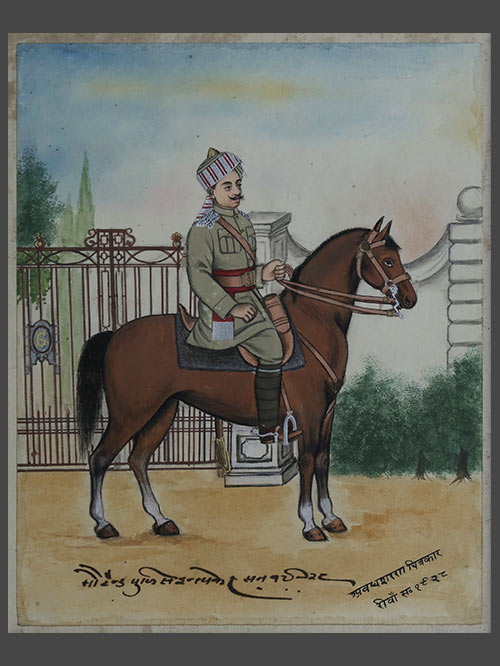

Rewa (Central India)
pigments on paper
Company Painting, Signed by the artist Avadh Sharan
A charming Company painting of a mounted Police Officer from Rewa in Central India. Unusually the painting is signed by the artist Avadh Sharan and also dated 1928. Originally bound in an album.
‘Company’ is a designation given to works by Indian artists painted in a mixed Indo-European style for the various East India companies. The foundation of this Indo-European style can be traced to the establishment of the first Portuguese trading posts. The British only counted as patrons in the 1760s following Clive’s victory at Plassey in 1757 . Patronage by the British in effect followed the flag. Princely states never directly under British control produced little company art and important centres like Delhi and Agra only became so after the British stabilised the reason in the early 1800s. Photography gradually replaced the genre in the 1840s but the style lingered on until the late nineteenth century. Barring minor regional variations, Company Style took the same form in all the centres. The favourite subjects were trades, costumes, crafts and festivals. Also popular were topographical pictures of contemporary India and exotic flora and fauna.
Painting Size (cms): 22 (H) x 18 (W)
Painting Size (inch): 8.5 (H) x 7 (L)
Framed Size (cms): 36.5 (H) x 32 (W)
Framed Size (inch): 14.5 (H) x 12.5 (L)
-
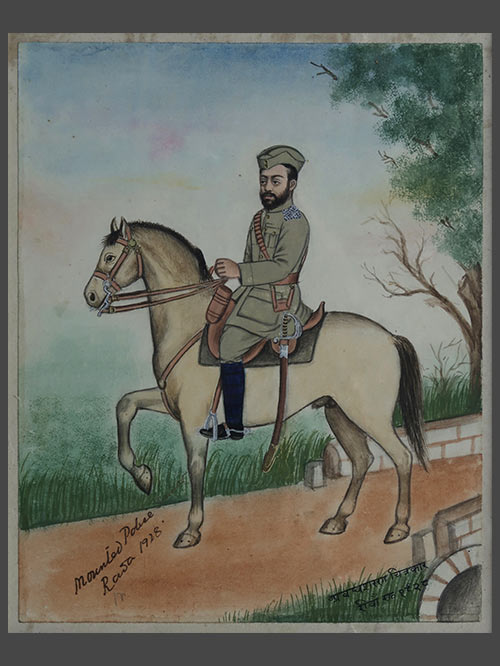
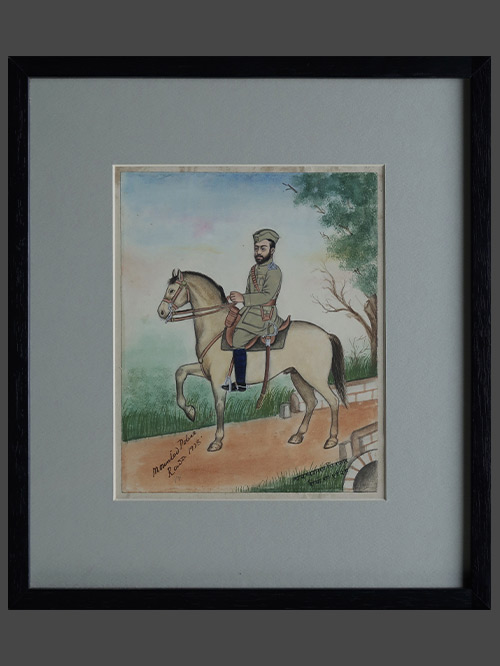
Rewa (Central India)
pigments on paper
Company Painting, Signed by the artist Avadh Sharan
A charming Company painting of a policeman captioned, “Mounted Police, Rewa.” Originally bound in an album. The Indian Police Services was part of the uniform system of police administration in British Raj, as established by Government of India Act 1858, Police Act of 1861. It was motivated by the danger experienced by the British during the 1857 rebellion. During 1920s the Imperial Indian police had 310,000 police in their contingent. Its members policed more than 300 million people in India, Pakistan, Bangladesh and Burma (then comprising British Raj). The police held a multiplicity of functions. As an agency of state coercion and intelligence gathering, the police were vital to Britain’s attempts to hold onto power in India. By the mid-1940s the erosion of police loyalty towards the British was an important index of Britain’s waning power.
‘Company’ is a designation given to works by Indian artists painted in a mixed Indo-European style for the various East India companies. The foundation of this Indo-European style can be traced to the establishment of the first Portuguese trading posts. The British only counted as patrons in the 1760s following Clive’s victory at Plassey in 1757 . Patronage by the British in effect followed the flag. Princely states never directly under British control produced little company art and important centres like Delhi and Agra only became so after the British stabilised the reason in the early 1800s. Photography gradually replaced the genre in the 1840s but the style lingered on until the late nineteenth century. Barring minor regional variations, Company Style took the same form in all the centres. The favourite subjects were trades, costumes, crafts and festivals. Also popular were topographical pictures of contemporary India and exotic flora and fauna.
Painting Size (cms): 22 (H) x 18 (W)
Painting Size (inch): 8.5 (H) x 7 (L)
Framed Size (cms): 36.5 (H) x 32 (W)
Framed Size (inch): 14.5 (H) x 12.5 (L)
-

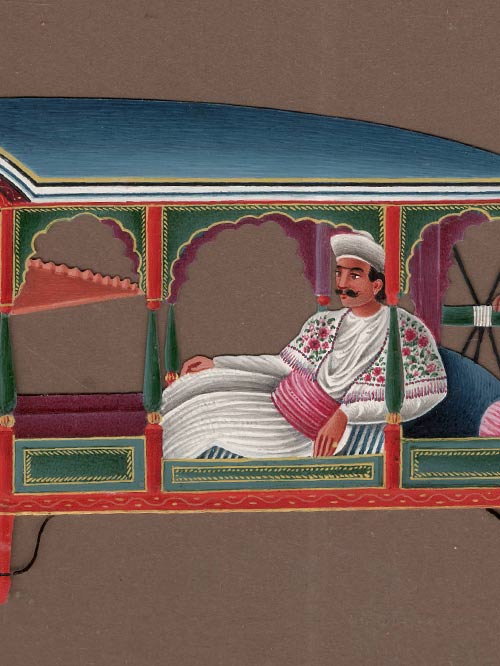
Patna (Eastern India)
Pigments on Mica
A charming and finely painted pair of mica paintings of palanquins carried by colourfully dressed palanquin bearers and a partially obscured parasol bearer. The closed palanquin affording only a glimpse of its seated patron, the open palanquin occupied by an elegantly dressed gentleman reclining against a large bolster wearing a floral patterned shawl.
Under the Mughals, Patna had never been a great artistic centre and although its Muhammadan governors had employed Mughal artists, there is no evidence that any strongly marked local style had developed. Yet Patna, like Murshidabad, was undergoing a social revolution and various circumstances in the later eighteenth century were to make it a centre of Indian-British painting. As a result of its increasing prosperity, a number of artists of the Kayasth caste were attracted to Patna from Murshidabad. One of these was a certain Sewak Ram, who had migrated there by 1790. He began to produce sets of occupations as well as large paintings of ceremonies and festivals. One such set, now in the India Office Library, was purchased by Lord Minto, while a painting from a similar set in the Indian Department of the Victoria and Albert Museum was acquired by Lord Amherst when he was Governor-General (August 1823 to March 1828). British taste in the early nineteenth century shows itself in both subjects and colour range – sepia wash enlivened with touches of brighter colour – adopted by the Patna artists.
Individual Sizes (cms): 11.5(H) x 18(Diam)
Individual Size (inches): 4.5(H) x 7(Diam)
-
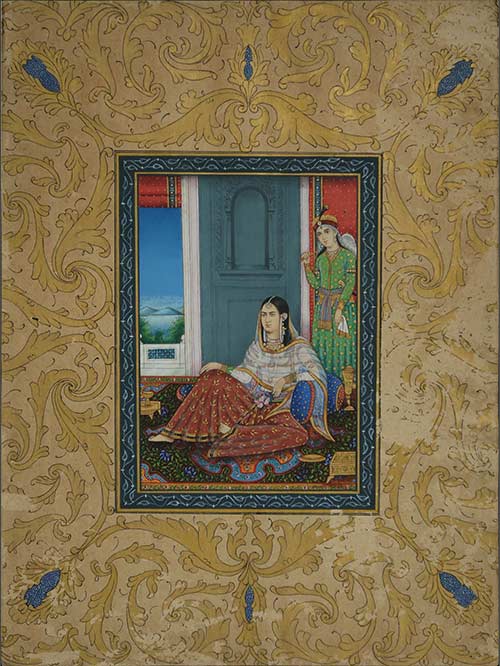
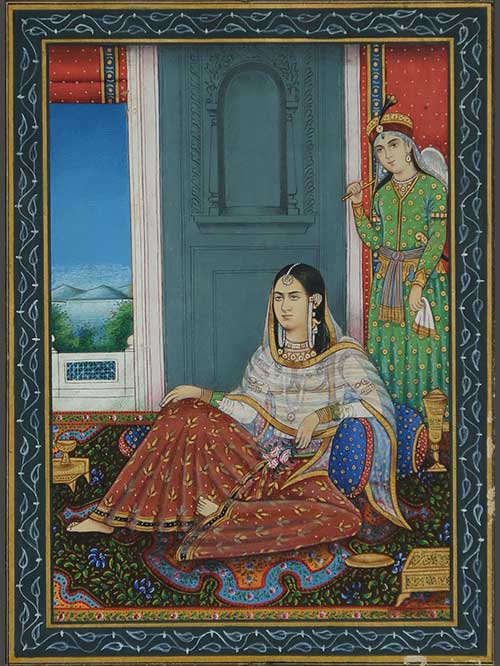
Delhi
pigments and gold on paper, painted gilt arabesque borders
A finely painted portrait of a seated lady, most likely a courtesan, as suggested by her stance and attire. She wears loose fitting pyjamas and a bodice under a diaphanous odhani or veil and is seated against a large blue bolster. A female attendant stands behind her holding a fly-whisk. Assorted gilded cups and a betel box are placed beside her on an intricately patterned floral carpet. A scene of a moonlit lake and hills visible in the distance through a marbled balcony.
Courtesans (tawaifs) occupied an honoured place in the Muslim cultures of India, especially in Lucknow and Delhi. They were trained to be women of great refinement, skilled in music and dancing and appreciative of courtly literature in Persian and Urdu. Their company was eagerly sought by the great men of Delhi, and they would entertain their visitors by performing a nautch (dance).
Miniature Size (cms): 18.3 (L) x 13.5 (W)
Miniature Size (inch): 7.2 (L) x 5.3 (W)
Page Size (cms): 33.5 (L) x 25 (W)
Page Size (inch): 13.2 (L) x 9.8 (W)
-
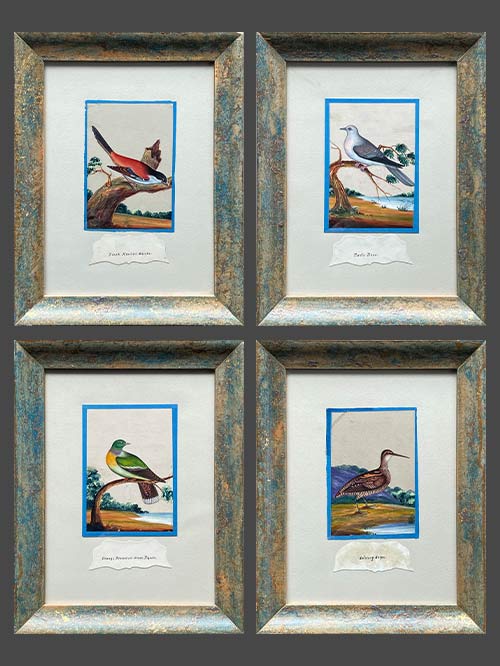
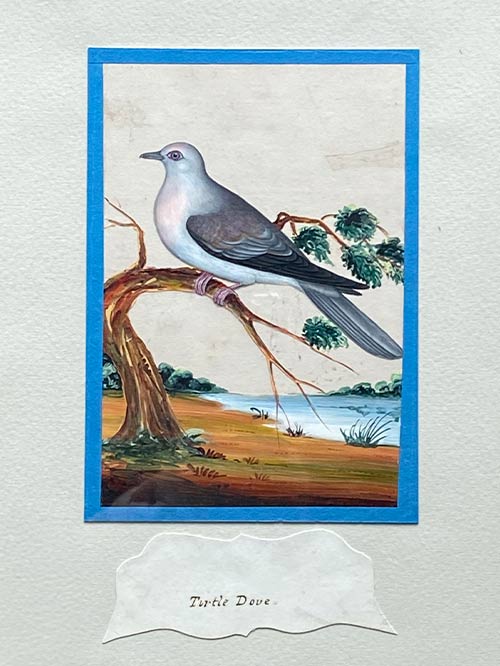
Trichinopoly (South India)
Pigments on Mica
Painting on mica (talc) was a novelty that greatly attracted the British in India and was made specifically for Europeans. Mica had long been used by Indian artists for preserving tracings of their family paintings. It was practised at Murshidabad, Patna and Benares in Eastern India and at Trichinopoly in South India. In South India mica was mined at Cuddapah and painted by artists at Trichinopoly. By the second half of the nineteenth century mica paintings depicting gods, rulers, festival scenes, castes, occupations, birds, flowers and butterflies were being produced there in their hundreds for sale to the British. South Indian mica painting is easily distinguished from that in Eastern India by its colour range, with arsenic green, lemon yellow and orange-brown predominating. Those in Eastern India favoured a blue.
This set of four mica paintings, each depicting a different bird, features original handwritten captions identifying each species. The birds showcased include the Black Headed Shrike, Turtle Dove, Orange Breasted Green Pigeon, and Solitary Snipe.
Painting Sizes (cms): 14(H) x 10.5(W) each
Painting Sizes (inches): 5.5(H) x 4.25(W) each
Framed Sizes (cms): 32.5(H) x 25.5(W) each
Framed Sizes (inches): 13(H) x 10(W) each
-
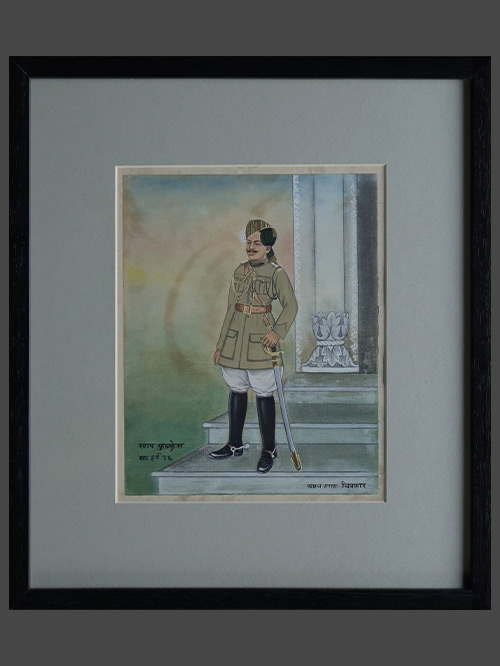
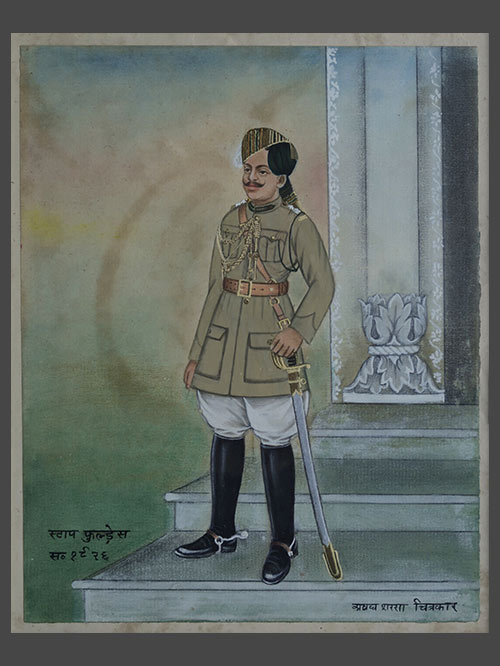
Rewa (Central India)
pigments on paper
Company Painting, Signed by the artist Avadh Sharan
A charming Company painting of a Staff officer captioned, “Staff Full-dress 1926.” Military personnel were chiefly shown in full dress by-military artists and photographers. Yet the undress uniform is equally important since the greater part of the military personnel’s daily life was spent in their undress uniform. Full-dress uniform, also known as a ceremonial dress uniform or parade dress uniform, is the most formal type of uniforms used by military and police. Full-dress uniforms typically include full-size orders and medals insignia.
The military staff was a group of officers, enlisted and civilian staff who serve the commander of a division or other large military unit in his command in a control role through planning, analysis, and information gathering, as well as by relaying, coordinating, and supervising the execution of his plans and orders. During this period, the Indian army was a separate organisation to the British Army. The main task of the Indian Army was to police the Indian Empire. During the first and second world wars, Indian troops served with distinction in France in 1940, Egypt, Libya, the Sudan, Abyssinia, Syria, Persia, Iraq, Malaya and Burma.
Painting Size (cms): 22 (H) x 18 (W)
Painting Size (inch): 8.5 (H) x 7 (L)
Framed Size (cms): 36.5 (H) x 32 (W)
Framed Size (inch): 14.5 (H) x 12.5 (L)
-

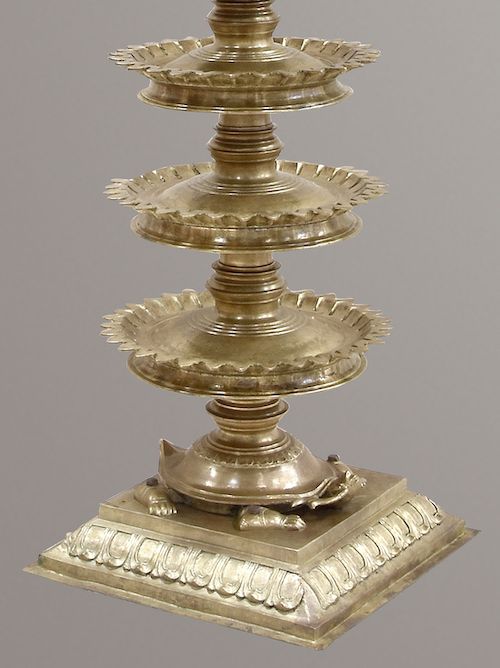
BRASS
c. 1900
SIZE (cms): 75 (W) X 74 (D) X 368 (H)

































